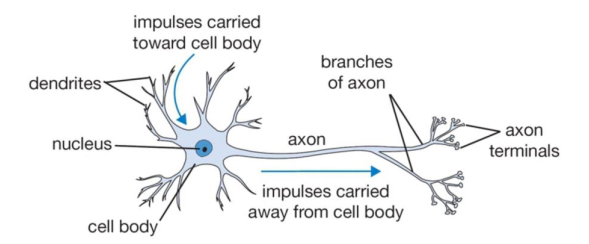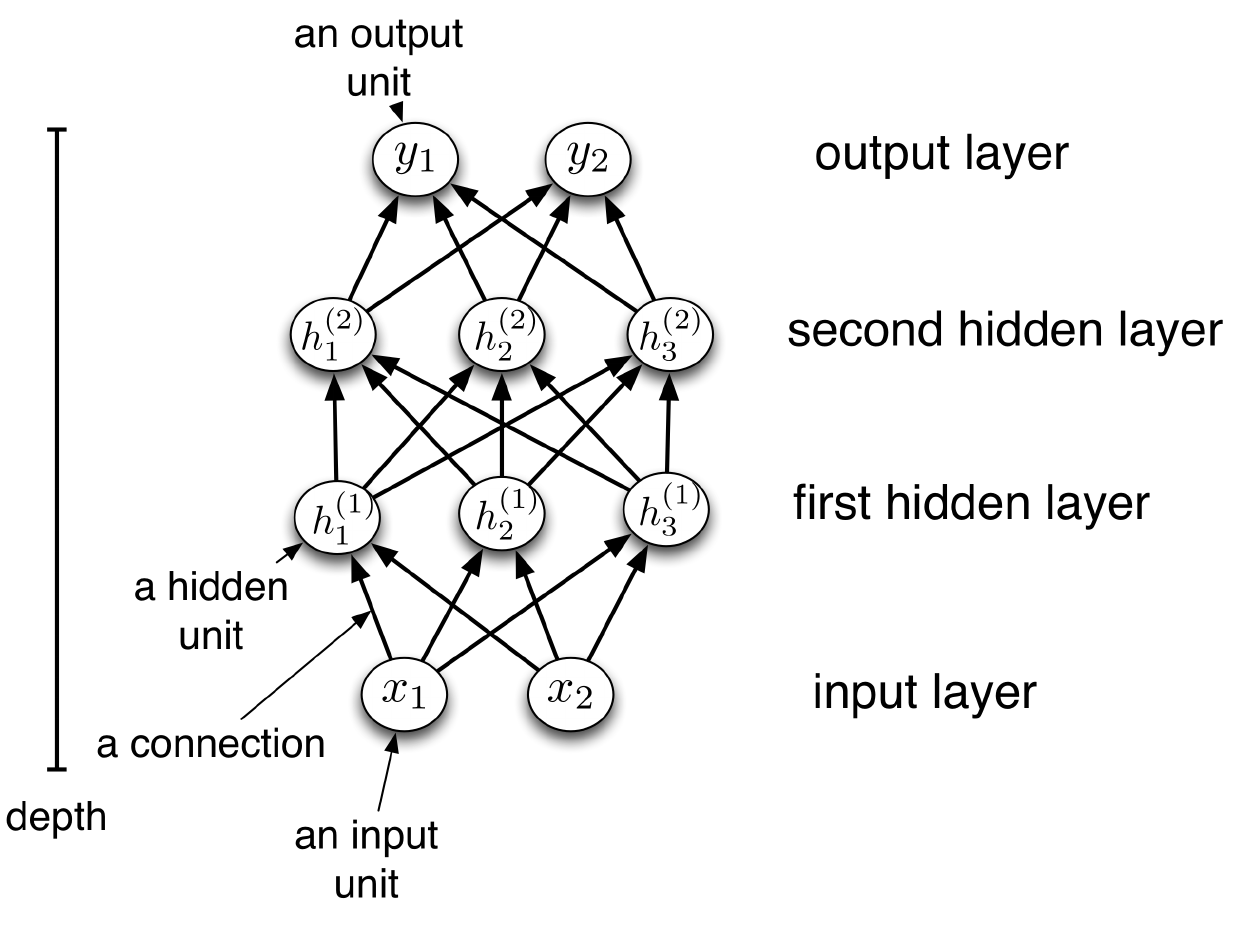Neural Networks 神经网络
- How do we train it?
- … which requires a calculus refresher ☺
- Why is everybody talking about it?
- Various ways to accelerate gradient descent
- Practical tips and tricks for training NNs
- 什么是(深度)神经网络
- 如何训练神经网络?
- 这需要温习一下微积分 ☺
- 为什么大家都在谈论它?
- 加速梯度下降的各种方法
- 训练神经网络的实际技巧和诀窍
- What is a Neuron?
- Architectures and Activation Functions
- Loss-functions
- Backpropagation and the Chain Rule
- Computation graphs
Advanced Topics: - Accelerating gradient descent - Regularization in Neural Networks - Practical considerations
- 什么是神经元?
- 架构和激活函数
- 损失函数
- 反向传播和链式法则
- 计算图
深入话题:
- 加速梯度下降
- 神经网络中的正则化
- 实际考虑因素
Biological Inspiration: The brain 生物学灵感:大脑
A neuron is the basic computational unit of the brain:
神经元是大脑的基本计算单元:

- Our brain has ~ 1011 neurons
- Each neuron is connected to ~ 104 other neurons (via synapses)
- Synapses have different connectivity
-
Approx. model: Input impulses are weighted by synapse strength and added up
- 我们的大脑有大约10^11个神经元。
- 每个神经元通过大约10^4个突触连接到其他神经元。
- 突触具有不同的连接方式。
- 近似模型:输入脉冲通过突触的强度加权并相加。
Neurons receive input signals and accumulate voltage. After some threshold they will fire spiking responses (highly non-linear response).
神经元接收输入信号并积累电压。 在达到某个阈值后,它们将激发尖峰响应(高度非线性响应)。

Artificial Neurons 人工神经元
For neural nets, we use a much simpler unit (neuron, perceptron):
对于神经网络,我们使用更简单的单元(神经元、感知器):

Example we already know:
- Logistic regression 逻辑回归

Feedforward Neural Networks 前馈神经网络
Building a network:
- We can connect lots of units together into a directed acyclic graph.
- This gives a feed-forward neural network. That’s in contrast to recurrent neural networks, which can have cycles.
- Typically, units are grouped together into layers.
- Each layer connects N input units to M output units.
- In the simplest case, all input units are connected to all output units. We call this a fully connected layer.
- Note: the inputs and outputs for a layer are distinct from the inputs and outputs to the network
构建一个网络:
- 我们可以将很多单元连接在一起形成一个有向无环图。
- 这就得到了一个前馈神经网络。与循环神经网络形成对比,后者可以有循环。
- 通常,单元被分组成层。
- 每一层将N个输入单元连接到M个输出单元。
- 在最简单的情况下,所有输入单元都连接到所有输出单元。我们称之为全连接层。
- 注意:层的输入和输出与网络的输入和输出是不同的。

- I.e., each layer has a M x N weight matrix W
- Equation in matrix form: $\mathbf{y}=\phi(\mathbf{W} \mathbf{x}+\mathbf{b})$
- Output units are a function of input units
-
Feedforward neural networks are also often called multi-layer perceptrons (MLPs)
- 每一层具有一个大小为M x N的权重矩阵W。
- 以矩阵形式的方程为:$\mathbf{y}=\phi(\mathbf{W} \mathbf{x}+\mathbf{b})$
- 输出单元是输入单元的函数。
- 前馈神经网络通常也被称为多层感知器(MLP)

Activation funcitons 激活函数
Different activation functions for introducing non-linearities: 引入非线性的不同激活函数:


计算:
\[\sigma(x)=\frac{1}{1+\exp (-x)}\]- 将数字压缩到范围[0,1]
- 从历史上来看它们非常流行,因为它们可以很好地解释为神经元的饱和“发射率”
常用的激活函数(如Sigmoid函数)在输入值较大或较小的情况下会饱和,即输出值接近0或1,并具有类似于神经元发射的特性。因此,这些激活函数的输出值可以被解释为神经元的饱和“发射率”。
问题:
- 饱和的神经元会使得梯度消失
- Sigmoid函数的输出不以零为中心(对于初始化很重要)
- exp()计算耗费资源

- 将数字压缩到范围[-1,1]
✓ 以零为中心(很好)
× 当饱和时仍然会消失梯度

修正线性单元(Rectified Linear Unit,ReLU)
计算: $f(x)=\max (0, x)$
✓ 不会饱和(在正区间内)
✓ 计算效率非常高
✓ 在实践中比sigmoid/tanh函数收敛速度快得多(例如,快6倍)
× 输出不以零为中心
× 对于x < 0没有梯度

计算: $f(x)=\max (0.1 x, x)$
✓ 不会饱和
✓ 计算效率高
✓ 在实践中收敛速度比sigmoid/tanh函数快很多!(例如,6倍)
✓ 不会“消失”
Parametric Rectifier (PReLu):
参数整流器 (PReLu):
计算: $f(x)=\max (\alpha x, x)$
Also learn alpha

指数线性单元
计算:
\[f(x)= \begin{cases}x & \text { if } x>0 \\ \alpha(\exp (x)-1) & \text { if } x \leq 0\end{cases}\]其中,alpha是一个预定义的常数,通常取一个较小的正数。
✓ 具有ReLU的所有优点
✓ 输出接近零均值
× 计算过程中需要使用exp()函数
In practice:
- 使用ReLU。在学习率和初始化时要小心。
对于学习率(learning rate),选择一个合适的值非常重要。过大的学习率可能导致训练不稳定或发散,而过小的学习率可能导致收敛速度过慢。
对于初始化(initialization),权重和偏置的初始值也需要谨慎选择。使用不合适的初始化方法可能导致梯度消失或梯度爆炸等问题,影响网络的训练效果。对于使用ReLU的网络,一种常见的初始化方法是使用较小的随机值,如从均匀分布或正态分布中采样得到的值。
- 尝试使用Leaky ReLU / ELU。
- 尝试使用tanh函数,但不要期望太多。
- 不要使用sigmoid函数。
- sigmoid函数仅在分类问题的输出激活中使用。
Formalisation:
每层计算一个函数,因此网络计算函数的组合:
\[\begin{aligned} \mathbf{h}^{(1)} & =f^{(1)}(\mathbf{x}) \\ \mathbf{h}^{(2)} & =f^{(2)}\left(\mathbf{h}^{(1)}\right) \\ \vdots & \end{aligned}\]或者更简单地:
\[\begin{aligned} & \mathbf{y}=f^{(L)}\left(\mathbf{h}^{(L-1)}\right) \\ & \mathbf{y}=f^L \circ f^{L-1} \circ \ldots f^{(1)}(\mathbf{x}) \end{aligned}\]神经网络提供模块化:我们可以将每一层的计算实现为一个黑盒子

Example: XOR 异或
设计一个实现 XOR 的网络:


- 单个单元无法计算!
- 经典的例子,为什么我们需要多层次
XOR in terms of elemental operations:
XOR(a,b) = (a OR b) AND NOT (a AND b)
设计一个实现XOR的网络:
- 激活函数的硬阈值,x1和x2是二进制的
- h1 计算 x1 OR x2
- h2 计算 x1 AND x2
- y 计算 h1 AND NOT h2

Deep Architectures深层架构
为什么我们需要深入?
- 任何线性层序列都可以用单个线性层等效地表示
即,我们需要非线性,以利用多个层次
- 具有非线性激活函数的FF-NN是通用函数近似器:
- 给定一个潜在的无限量的单元,它们可以任意地逼近任何函数
- 通用函数逼近定理: 单层就足以实现 “普适性”
那么,单层是否足够?
- 尽管通用函数逼近定理表示单层理论上足够,但实际上我们需要指数级(与输入维度成正比)的神经元数量才能实现这一点。
- 如果可以学习任何函数,那么结果很可能会过拟合。
- 相反,多层网络可以用更少的神经元实现类似的效果。
- 紧凑的表示方式比”通用表示”更有效。
Loss-functions 损失函数
训练神经网络的目标函数:
通用的机器学习方法:逐样本损失 + 正则化惩罚
\[\boldsymbol{\theta}^*=\underset{\text { parameters } \boldsymbol{\theta}}{\arg \min } \sum_{i=1}^N l\left(\boldsymbol{x}_i, \boldsymbol{\theta}\right)+\lambda \text { penalty }(\boldsymbol{\theta})\]对于不同的任务,损失函数和输出激活函数的选择有所不同:
- 回归任务(Regression):通常使用均方误差(Mean Squared Error)作为损失函数,输出激活函数可以是线性函数或恒等函数。
- 二分类任务(Binary Classification):常见的损失函数包括二元交叉熵(Binary Cross-Entropy)或对数损失(Log Loss),输出激活函数通常选择sigmoid函数。
- 多类别分类任务(Multi-class Classification):常用的损失函数是多类别交叉熵(Categorical Cross-Entropy),输出激活函数则通常选择softmax函数。
Regression 回归
negative log-likelihood 负对数似然 $$ l_i\left(\mathbf{x}_i, \boldsymbol{\theta}\right)=-\log \mathcal{N}\left(\mathbf{y}_i \mid \boldsymbol{\mu}\left(\mathbf{x}_i\right), \boldsymbol{\Sigma}\right) $$
Binary classification 二元分类
neg-loglike 负对数似然 $$ \begin{aligned} l_i\left(\mathbf{x}_i, \boldsymbol{\theta}\right)= & -c_i \log f\left(\mathbf{x}_i\right)-\left(1-c_i\right) \log \left(1-f\left(\mathbf{x}_i\right)\right) \end{aligned} $$
其中$y_i$是 -1/+1 labels, $c_i$ 是0/1 labels。
Multi-class classification 多类别分类
neg-loglike 负对数似然 $$ l_i\left(\mathbf{x}_i, \boldsymbol{\theta}\right)=-\sum_{k=1}^K \boldsymbol{h}_{c_i, k} \log y_k\left(\mathbf{x}_i\right) $$
其中 $\boldsymbol{h}_{c_i, k}$ 是 one hot coding
One-hot encoding是一种常用的数据预处理技术,用于将离散特征表示为二进制向量的形式。它常用于机器学习和深度学习任务中,特别是当特征数据中包含分类变量时。
在One-hot encoding中,如果一个特征具有n个不同的类别,那么它将被表示为一个长度为n的二进制向量,其中只有一个位置为1,其他位置都为0。被设置为1的位置对应于该特征所属的类别。
这样的编码方式有助于解决以下问题:
解决分类变量的数值化问题:分类变量通常无法直接用于机器学习算法,因为算法通常期望输入是数值型数据。One-hot encoding可以将分类变量转换为数值型数据,使其适用于算法的处理。
避免特征之间的顺序关系:One-hot encoding将每个类别都独立地表示为一个二进制向量,不考虑类别之间的顺序关系。这在一些情况下是有益的,例如避免算法错误地学习到类别之间的顺序或大小关系。
需要注意的是,当原始特征具有大量类别时,One-hot encoding会导致特征空间的维度增加,可能会导致稀疏矩阵和计算资源的浪费。在处理高维稀疏数据时,可能需要考虑其他的特征编码方法。
在实践中,可以使用多种编程语言和库来执行One-hot encoding,例如Python中的scikit-learn、pandas和TensorFlow等。
Feature Learning 特征学习
神经网络可以被看作是一种学习特征的方式
- 最后一层是标准的线性回归/分类层
网络学习特征$\psi(\mathbf{x})$使得线性回归/分类可以解决它


